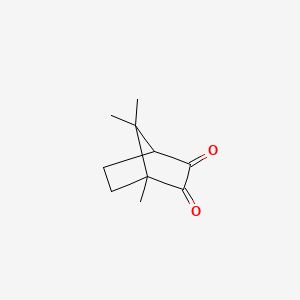| MeSH term | MeSH ID | Detail |
|---|---|---|
| Hemolysis | D006461 | 131 associated lipids |
| Body Weight | D001835 | 333 associated lipids |
| Dental Leakage | D003763 | 5 associated lipids |
Camphorquinone
Camphorquinone is a lipid of Prenol Lipids (PR) class. The involved functions are known as Polymerization. The related lipids are camphoroquinone.
Cross Reference
Introduction
To understand associated biological information of Camphorquinone, we collected biological information of abnormalities, associated pathways, cellular/molecular locations, biological functions, related genes/proteins, lipids and common seen animal/experimental models with organized paragraphs from literatures.
What diseases are associated with Camphorquinone?
There are no associated biomedical information in the current reference collection.
Possible diseases from mapped MeSH terms on references
We collected disease MeSH terms mapped to the references associated with Camphorquinone
PubChem Associated disorders and diseases
What pathways are associated with Camphorquinone
There are no associated biomedical information in the current reference collection.
PubChem Biomolecular Interactions and Pathways
Link to PubChem Biomolecular Interactions and PathwaysWhat cellular locations are associated with Camphorquinone?
There are no associated biomedical information in the current reference collection.
What functions are associated with Camphorquinone?
Related references are published most in these journals:
| Function | Cross reference | Weighted score | Related literatures |
|---|
What lipids are associated with Camphorquinone?
Related references are published most in these journals:
| Lipid concept | Cross reference | Weighted score | Related literatures |
|---|
What genes are associated with Camphorquinone?
There are no associated biomedical information in the current reference collection.
What common seen animal models are associated with Camphorquinone?
There are no associated biomedical information in the current reference collection.
NCBI Entrez Crosslinks
All references with Camphorquinone
Download all related citations| Authors | Title | Published | Journal | PubMed Link |
|---|---|---|---|---|
| Miletic V and Santini A | Micro-Raman spectroscopic analysis of the degree of conversion of composite resins containing different initiators cured by polywave or monowave LED units. | 2012 | J Dent | pmid:22094322 |
| Yaman BC et al. | The effects of halogen and light-emitting diode light curing on the depth of cure and surface microhardness of composite resins. | 2011 | J Conserv Dent | pmid:21814353 |
| Krithikadatta J | Clinical effectiveness of contemporary dentin bonding agents. | 2010 | J Conserv Dent | pmid:21217944 |
| Neelagiri K et al. | Effects of saliva contamination and decontamination procedures on shear bond strength of self-etch dentine bonding systems: An in vitro study. | 2010 | J Conserv Dent | pmid:20859478 |
| Ghivari S et al. | Role of oxygen inhibited layer on shear bond strength of composites. | 2010 | J Conserv Dent | pmid:20582218 |
| Sehgal A et al. | Evaluation of the effects of the oxygen-inhibited layer on shear bond strength of two resin composites. | 2008 | J Conserv Dent | pmid:20351974 |
| Hegde MN et al. | The influence of salivary contamination on the shear bond strength of two newer generation dentin bonding agents - An in vitro study. | 2008 | J Conserv Dent | pmid:20142900 |
| Hegde MN et al. | Evaluation of depth of cure and knoop hardness in a dental composite, photo-activated using different methods. | 2008 | J Conserv Dent | pmid:20142889 |
| Nandini S | Indirect resin composites. | 2010 | J Conserv Dent | pmid:21217945 |
| Hegde MN and Bhandary S | An evaluation and comparison of shear bond strength of composite resin to dentin, using newer dentin bonding agents. | 2008 | J Conserv Dent | pmid:20142888 |
